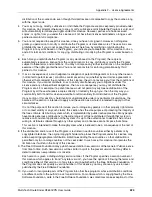
Glossary
Multi-Tech RouteFinder RF650VPN User Guide
234
connections between two computers. A connection on the TCP and UDP level are thus clearly identified
by the source address and the source port, as well as by the target address and the target port.
Port Range
– A series of TCP or UDP port numbers that can be set in RouteFinder protocol service
definitions. For example, when adding a service from From Definitions|Services, enter the source (client)
port. The entry options are a single port (e.g. 80), a list separated by commas (e.g. 25, 80, 110), or a port
range (e.g. 1024:64000).
Port Scanning
– Attempting to find "listening" UDP or TCP ports on an IP device, and then obtaining
information about the device. Portscanning itself is not harmful, but it can be used by hackers to allow
intrusion by brute-force password guessing.
PPP (Point-to-Point Protocol)
–
An IETF standard which provides a method for transporting multi-
protocol datagrams over point-to-point links. All of the users on the Ethernet connection share a common
connection, so the Ethernet principles supporting multiple users in a LAN are combined with the principles
of PPP, which typically apply t serial connections.
PPPoE (Point-to-Point Protocol over Ethernet)
– An IETF standard which provides the ability to
connect a network of hosts over a simple bridging access device to a remote access concentrator. To
provide a point-to-point connection over Ethernet, each PPP session must learn the Ethernet address of
the remote peer, as well as establish a unique session identifier.
PPTP (Point-To-Point Tunnelling Protocol)
– A protocol that allows secure remote access to corporate
networks (VPNs) over the Internet. All data sent over a PPTP connection can be encrypted and
compressed, and multiple network level protocols (TCP/IP, IPX) can be run concurrently. Note: the
RF650VPN does NOT support IPX or Netbeui when using PPTP tunneling.
Protocol
– A clearly-defined and standardised sentence of commands and answers, with whose help a
client and a server can communicate. Well known protocols and the services they provide are, for
example, HTTP (www), FTP (ftp) and NNTP (news).
Proxy (Application Gateway)
– The task of a proxy (Application Gateway) is to completely separate the
communication connections between the external network (Internet) and the internal network (LAN).
There may must be no direct connection between an internal system and an external computer. The
proxies work exclusively on the application level. Firewalls that are based on proxies use a dual homed
gateway that does not transfer any IP packets. The proxies that run as specialised programs on the
gateway can now receive connections for a special protocol, process the received information at the
application level and then transfer them.
Proxy ARP
– The technique in which one machine, usually a router, answers ARP requests intended for
another machine. By "faking" its identity, the router accepts responsibility for routing packets to the "real"
destination. Proxy ARP allows a site to use a single IP address with two physical networks. Subnetting
would normally be a better solution.
Private Key
–
In public key cryptography the private key is only known to the holder, and it can be used
to sign and decrypt messages.
Proxy
– A cache server that acts as a firewall, protecting the local network. It allows an application inside
the proxy to access resources on the global Internet.
PSK (Pre Shared Key)
– A PSK password must be entered at both ends of the VPN tunnel. This
password is also called the secret. The holder of this password can establish a VPN connection to the
secure network. Make sure that this password does not reach the wrong hands, and that you change the
PSK password at regular intervals.
Public Key
– In public key cryptography the public key, which is included in the certificate, can be used to
verify signatures and encrypt messages. A sample public key is shown below:
0sAQNic1Twvw7iknvNd6ieKDhd9JTu/Krbc71H4oIFd/xqKJnt
U8x25M0Wbxr0gQngECdZPWHj6KeSVtMtslzXMkxDecdawo
CadPtPiH/Iln23GKUOt3fob9wBYbwdHOxPAYtN





































